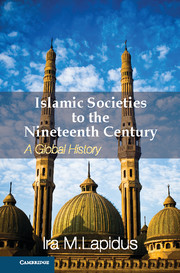Book contents
- Frontmatter
- Contents
- List of Illustrations
- List of Figures
- List of Maps
- List of Tables
- Preface
- Acknowledgments
- Acknowledgments to the first edition of A History of Islamic Societies
- Acknowledgments to the second edition of A History of Islamic Societies
- Publisher's Preface
- Introduction to Islamic Societies
- Part I The Beginnings of Islamic Civilizations
- Part II From Islamic Community to Islamic Society
- Part III The Global Expansion of Islam from the Seventh to the Nineteenth Centuries
- Chapter 25 Introduction: Islamic Institutions
- The Western Islamic Societies
- Islam in Asia
- Islam in Africa
- Conclusion
- Chapter 43 The Varieties of Islamic Societies
- Chapter 44 The Global Context
- Glossary
- Bibliography
- Annotated Bibliography from A History of Islamic Societies, 2nd Edition
- Index
Chapter 43 - The Varieties of Islamic Societies
Published online by Cambridge University Press: 05 February 2013
- Frontmatter
- Contents
- List of Illustrations
- List of Figures
- List of Maps
- List of Tables
- Preface
- Acknowledgments
- Acknowledgments to the first edition of A History of Islamic Societies
- Acknowledgments to the second edition of A History of Islamic Societies
- Publisher's Preface
- Introduction to Islamic Societies
- Part I The Beginnings of Islamic Civilizations
- Part II From Islamic Community to Islamic Society
- Part III The Global Expansion of Islam from the Seventh to the Nineteenth Centuries
- Chapter 25 Introduction: Islamic Institutions
- The Western Islamic Societies
- Islam in Asia
- Islam in Africa
- Conclusion
- Chapter 43 The Varieties of Islamic Societies
- Chapter 44 The Global Context
- Glossary
- Bibliography
- Annotated Bibliography from A History of Islamic Societies, 2nd Edition
- Index
Summary
By the eighteenth century Muslim societies had come into being throughout Asia, Africa, and Eastern Europe. Each was built on the interaction of Middle Eastern Islamic state, religious, and communal institutions with local social institutions and cultures, and in each case the interactions generated a different type of Islamic society. Although each society was unique, they resembled one another in form and were interconnected by political and religious contacts and shared values. Thus they made up a world system of Islamic societies.
Islamic societies from the tenth to the nineteenth centuries had a complex structure. In some cases Muslim communities were isolated pastoral, village, or urban minorities living within non-Islamic societies. Examples of this type are lineage groups united by shrine veneration in the northern steppes of Inner Asia and parts of the Sahara and merchant communities in China or West Africa. In African societies the Muslim presence was centered around small communities such as lineage groups, teachers and disciples, Sufi brotherhoods, or networks of merchants. Merchant communities were established as early as the eleventh and twelfth centuries in the western Sudan. By the eighteenth century, there were Muslim merchant enclaves in the central Sudan, Berber holy lineages in the Sahara region (zawaya or insilimen), cultivator and merchant communities and scholarly lineages such as the Saghanughu (called Wangara or Dyula) in the Volta River basin and Guinean forests, and Jakhanke lineages of cultivators and scholars in the Senegambia region. In East Africa, Muslim communities were settled in the coastal towns. In Ethiopia and Somalia they were present among Galla and Somali peoples. In general the Muslim communities were scattered, had no territorial identity, and did not constitute governments.
- Type
- Chapter
- Information
- Islamic Societies to the Nineteenth CenturyA Global History, pp. 635 - 643Publisher: Cambridge University PressPrint publication year: 2012



